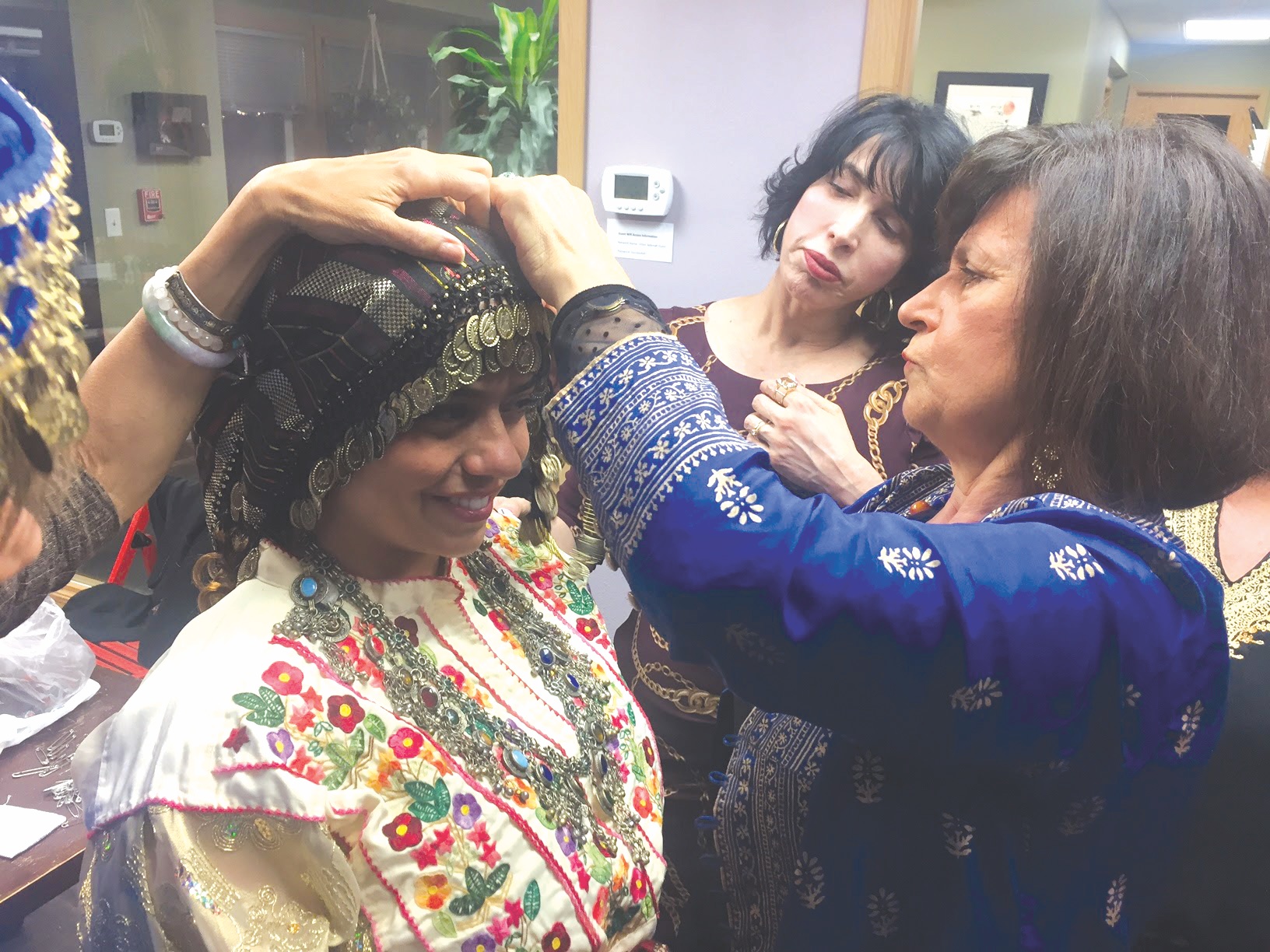 A mock Moroccan wedding held at a Mimouna celebration organized by JIMENA at Urban Adamah, an educational farming community center in Berkeley. Photo courtesy of JIMENA.
A mock Moroccan wedding held at a Mimouna celebration organized by JIMENA at Urban Adamah, an educational farming community center in Berkeley. Photo courtesy of JIMENA. Rabbi Daniel Bouskila, director of the Sephardic Education Center, has celebrated Mimouna his entire life.
He credits his Moroccan father and Algerian mother with introducing him to the North African, post-Passover tradition, during which people feast on an array of sweet Sephardic foods, some with chametz, others without, including the popular moufleta, a sweet tortilla-like treat smeared with honey, butter or jam. Additionally, Arabic music, the blessings of good fortune and the coming together with neighbors, family and friends are important components of Mimouna.
Today, the Los Angeles Sephardic community leader carries on the centuries-old tradition. Despite being an integral part of the Sephardic Passover experience as well as something akin to a national holiday in Israel, many non-Sephardic Jews in the Diaspora do not know about Mimouna.
Mimouna commences immediately after sunset on the final day of Passover. Havdalah is recited to mark the end of the holiday. Then, while an Ashkenazi family may head out for pizza, those who celebrate Mimouna open their homes or visit the homes of others, greet each other with the Judeo-Arabic “Tirbah u’tissad,” (May you prosper and succeed), reminiscent of the Vulcan salute, “Live long and prosper,” from “Star Trek.” They then eat a date, filled with butter and honey, and scarf down two or three of the aforementioned moufleta. The ingredients are purchased before Passover and sold with the other chametz, or purchased hastily shortly before Mimouna begins.
Traditional Mimouna foods include dried fruits, marzipan pastries, sesame cookies, and other treats that celebrate the renewal of spring.
Those who celebrate often dress in traditional Moroccan garb, including a kaftan, (embroidered dresses for women), and jalabiya (long robes for men).
“There is kind of a whole rhythm to what Mimouna is,” Bouskila told the Journal in a phone interview.
When Bouskila’s father was growing up in Marrakesh before the founding of the State of Israel, Mimouna was also an illustration of coexistence between Jews and Muslims who lived side-by-side, he said.
“My father remembered that distinctly. The afternoon of the last day of Pesach, a lot of the materials that were needed for the Mimouna, the Muslims used to help them prepare for it, because it was still yom tov, and the Muslims knew that.”
While the coming together of Jews and Muslims in Arab countries on Mimouna does not happen much today, given that there are not many Jews left in Arab countries, the celebration is an opportunity for Sephardic and Ashkenazi Jews to come together, Bouskila said.
In 2015, I attended a Mimouna celebration for young professionals organized by Reform synagogue Temple Emanuel of Beverly Hills and Jews Indigenous to the Middle East and North Africa (JIMENA). Henna stations, tables featuring a buffet of Sephardic foods and the live music of Middle Eastern band Bazaar Ensemble welcomed the large crowd of Ashkenazi, Sephardic and Mizrahi Jews at a tucked-away warehouse space.
“Beyond understanding the specifics of why something began, it is what kept us as a people.” — Odin Ozdil
This year, on April 11, four days after Passover ends, JIMENA — in partnership with Students Supporting Israel at UCLA and Jewish Awareness Movement (JAM) — will hold a Mimouna gathering for college students at JAM’s UCLA location, featuring a henna station, moufletas and other Middle Eastern food and Moroccan lantern- and challah-making.
Additionally, Hillel 818, which serves Jewish students at Cal State Northridge, Pierce College and Los Angeles Valley College, is holding a students-only Mimouna party, on April 10.
Odin Ozdil, the L.A.-based program coordinator at JIMENA, said he is looking forward to introducing students to Mimouna. “It is events like Mimouna I can really rally the resources of the organization around,” he told the Journal.
Some believe the origins of the word “Mimouna” derive from the famous Jewish philosopher Maimonides. Others believe it is derived from the Hebrew word “emunah,” or “faith.” There is, however, nothing conclusive about its absolute origins.
Ozdil said that the origins do not matter as much as the result of the tradition of bringing people together.
“Beyond understanding the specifics of why something began, it is what kept us as a people,” he said. “Even not knowing is something worth celebrating that can empower a people moving forward.”
Eli Miller, 25, who runs the Sephardic community Midrasho Shel Shem out of his West Hollywood home, attracting Hebrew- and French-speaking transplants in Los Angeles, also will celebrate Mimouna this year. He plans to visit multiple homes in one night, staying at one house for about 15 minutes before going on to the next.
“It’s hard to be at a million places at once,” Miller said in a phone interview. “You make a stop and come in for a few minutes, listen to music, talk to some people and move on to the next one.”
For Bouskila, this practice of moving from one house to the next represents the essence of Mimouna.
“The idea of a Mimouna is that there is no such thing as a formal invitation. It is kind of an open house,” he said. “People just file in and out — neighbors, friends — through word of mouth. We often had people we didn’t know, people who heard about it and it was never, ‘What are you doing here? You’re not part of our dinner plans.’ It was just a continuous open house.”























 More news and opinions than at a Shabbat dinner, right in your inbox.
More news and opinions than at a Shabbat dinner, right in your inbox.